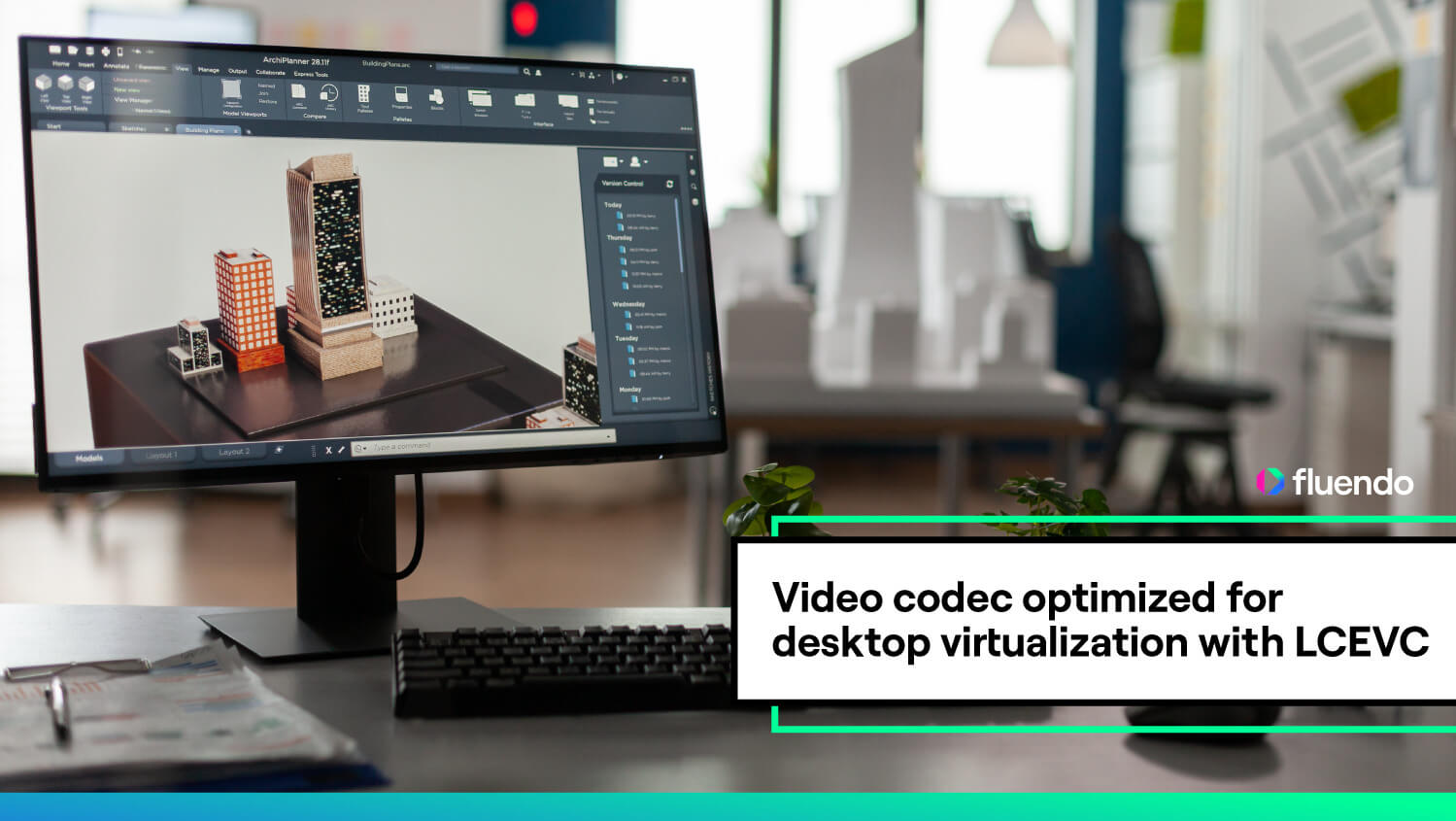
Video codec optimized for desktop virtualization with LCEVC

Written by
Sergio SánchezSeptember 7, 2023
In today’s digital age, there has been a surge in the popularity of many digital technologies in the workplace associated with streaming video of screen content [1], encompassing computer-generated text, graphics, and animations. This recognition further underscores the importance of addressing the specific requirements and challenges of optimizing video transmission for screen content.
With more than 15 years of expertise in multimedia technology, Fluendo has emerged as a leading provider of innovative solutions, bridging the gap between open-source and proprietary frameworks. Our mission is to empower individuals to enjoy, communicate, and collaborate seamlessly through effective multimedia solutions. Fluendo’s toolset enables decoding and encoding multimedia content on any Desktop as a Service (DaaS) or Virtual Desktop Infrastructure (VDI) endpoint.

Fluendo has been collaborating with V-Nova to offer our customers the best service and products.This partnership has provided us access to the LCEVC codec, an innovative video standard from MPEG. We are diligently working on an optimized implementation of the standard for DaaS/VDI environments.
LCEVC specifies an enhancement layer that combines with a base-encoded stream to produce an enhanced video stream [2]. In DaaS/VDI use cases, a desktop virtualization server engine in the cloud renders content, encodes it as video, and sends it through a standard IP connection to a light, power-efficient client device. LCEVC should enable [3] the necessary bitrates to achieve the optimal quality to be lowered beyond what is possible with AVC, HEVC, or AV1 alone while maintaining minimum latency, reducing jitter, and may be possible to utilize less computational power associated with lower encoding costs and CO2 emissions.
Although LCEVC shows excellent potential, its implementation in desktop virtualization has yet to be fully developed. We at Fluendo see this as an opportunity for exploration. The importance of thorough evaluation cannot be overstated, and with this in mind, we now turn to a detailed examination of our testing procedures and findings. Eight test clips representing a wide range of desktop/screen content found in DaaS/VDI use cases have been used for reference.
The most popular and efficient implementation of h.264 is x264®, a commercial product of VideoLAN*****. We tested at various bit rates, resolutions, and settings to find ways to produce the highest quality, most efficient LCEVC with x264® as the base codec video for desktop content. Figure 2 shows that LCEVC with x264® as the base layer enables a 21.86% bandwidth reduction for screen/desktop content while increasing maximum VMAF quality scores.

We found a high dependency between the content type and the encoding performance with LCEVC with x264® as the base codec (Figure 3). This result clearly demonstrates the importance and effectiveness of custom-tailored solutions for individual use cases.
*VideoLAN is a separate, unrelated entity from Fluendo and V-Nova. x264® is a registered trademark of VideoLAN.

Fine-tuned LCEVC enhancement significantly simplifies the encoding process compared to using x264® alone. This means less time and computing resources are required to encode the video in the most complex encoding scenarios, such as achieving the best quality/compression balance and highest resolutions. Our downloadable report below provides more detailed information.
Using fewer computing resources improves performance and reduces carbon emissions, contributing to environmental sustainability. We continuously research greener codecs as part of our commitment to sustainability and efficiency for a better multimedia experience.
The cost of running a live video streaming service for a DaaS application is determined by a combination of codec complexity, bit rate, and output video resolution. The following table shows the results of a cost estimate using x264® vs. LCEVC on top of x264® tuned by Fluendo for a proposed use case of streaming 1080p HD video at a 15 Mbps bitrate using the AVC codec with an average of 1000 clients connected to the service with an average consumption of 4 Mbps. Our optimized solution can reduce operational costs from 243.11 $/h to only 191.03 $/h, achieving 52.08 $/h savings with only 1000 clients. The potential savings over a year are around 600.000 $ for every thousand clients.
Table: Results of a cost estimate using LCEVC with x264® as base codec tuned by Fluendo vs. x264®. Cost savings are 21.4%.
| x264® | LCEVC with x264® as a base codec | |
|---|---|---|
| Video compression | 5.81 $/hour | 5.61 $/hour |
| Packaging | 87.89 $/hour | 68.67 $/hour |
| Video delivery | 149.41 $/hour | 116.75 $/hour |
| Total | 243.11 $/hour | 191.03 $/hour |
Final Thoughts
Following a comprehensive series of tests, we’ve successfully fine-tuned the configuration of LCEVC on top of x264®.This optimization reduces the encoding complexity and the required bandwidth while maintaining the same quality for desktop/screen content in DaaS use cases. The key takeaways are:
- The combination of x264® with LCEVC as an enhancement layer delivers the same visual quality at 22% of the bitrate.
- LCVEC reduces complexity in the encoding process for most cases, promoting a greener codec strategy by reducing power consumption and carbon footprint.
- 21.42% cost savings.
Notably, these gains have yet to be seen for all configuration combinations compared 1-to-1 between x264® alone and with LCEVC on the top as an enhancement layer.To achieve the magnificent results in this post, systematic work on the target content has been necessary, in this case, screen content for DaaS/VDI. Fluendo offers all of its experience demonstrated in this article to tune any codec to your use case. Do not hesitate to contact one of our experts for any questions about this content.
As part of our ongoing research initiatives, we are exploring the implications of using LCEVC with a YUV444 format. This format involves no chroma subsampling and maintains full-color information, which is especially relevant for high-quality text encoding. Preliminary findings indicate that this approach could lead to additional gains in both screen content and the desktop virtualization use case. More details on this active area of research are available in the full report.
If you are interested in more information about this study’s results, you can download the full report by filling out the form below:
References [1] Gartner_Inc (no date) 6 digital workplace trends on the Gartner hype cycle for the digital workplace, 2020, Gartner. Available here (Accessed: July 2023).
[2] Luiz FaustoChair of the Technical Module of SBTVD Forum and Technology & Regulatory Specialist at Globo et al. (2023) Low Complexity Enhancement Video Codec - LCEVC - a new approach to video compression, LCEVC. Available here (Accessed: July 2023).
[3] Guido Meardi, Simone Ferrara, Lorenzo Ciccarelli, Guendalina Cobianchi, Stergios Poularakis, Florian Maurer, Stefano Battista, Ahmad Byagowi, “MPEG-5 part 2: Low Complexity Enhancement Video Coding (LCEVC): Overview and performance evaluation,” Proc. SPIE 11510, Applications of Digital Image Processing XLIII, 115101C (21 August 2020).
